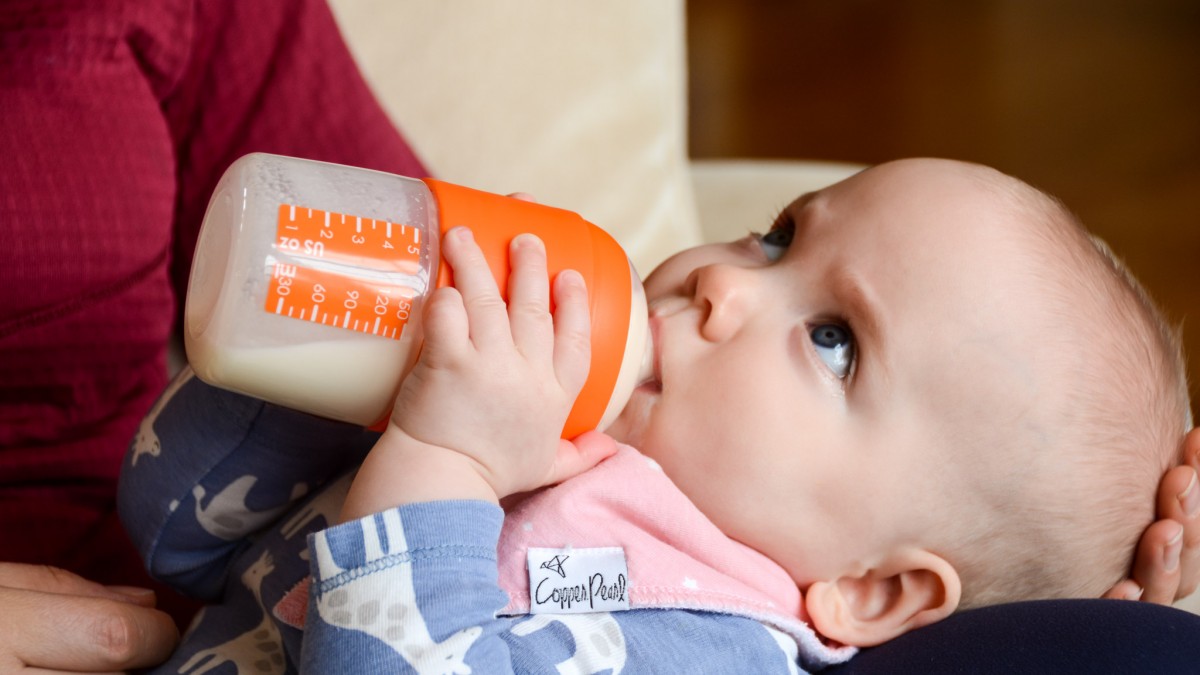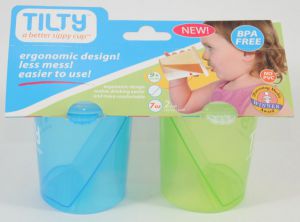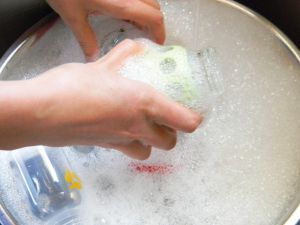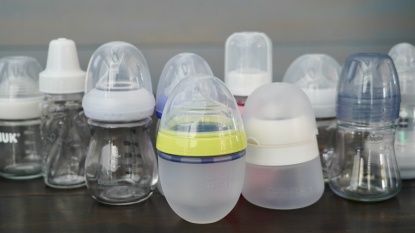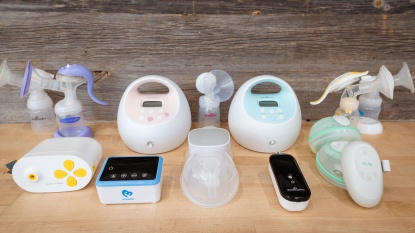When it comes to giving babies, toddlers, and children food and beverages, plastics are ubiquitous serving vessels. Both in hard and soft forms and most recyclable, plastics are convenient, lightweight, easy to clean, and durable. Indeed, plastic baby bottles, sippy cups, and plates are practically indestructible! But are they safe? And, are there healthier alternatives?
While Bisphenol A (BPA) became widely known as one potentially hazardous chemical used in plastic baby bottles and cups, experts say there are other chemicals which may leach from plastic baby bottles and cups in use.
But, Isn't Today's BPA-Free Plastic Safe for Babies?
The FDA banned BPA from use in baby bottles and cups in 2012. But, it may be a surprise to many that concerns about plastic leaching chemicals into food and drinks didn't end with the broad adoption of BPA-Free plastic formulations. Some recent studies suggest that even the BPA-Free plastics may pose a health risk to babies:
- Study: Most Plastics Leach Hormone-Like Chemicals, NPR, Mar 2011
- Even BPA-Free Plastic Not Always Safe, NBC Discovery News, Jul 2011
- Most Plastic Products Release Estrogenic Chemicals: A Potential Health Problem That Can Be Solved, Environmental Health Perspectives, Jul 2011 (study funded by a grant from the NIH)
Mother Jones recently published a very detailed article on the topic:
BPA Raised Awareness in 2009
Prior to 2009, BPA was widely used in many hard plastics, including polycarbonate baby bottles and sippy cups, to make them hard and clear. Now it is known that polycarbonate breaks down over time with typical use such as repetitive heating and cleaning in the dishwasher. Not surprisingly, BPA-tainted liquid, formula, milk, and other food and beverages is an end result.
FDA Bans BPA, But Still Says It's Safe. Huh!?!
The US Food and Drug Administration (FDA) officially banned BPA in baby bottles and children's cups in 2012. Yet, the path to that ban is confusing, and the FDA has not made an official ruling as to whether BPA actually poses a health risk. In 2008, the FDA boldly declared BPA safe. Yet, in 2010 the agency shifted their stance and expressed, “some concern about the potential effects of BPA on the brain, behavior and prostate gland of fetuses, infants and children.” The ban in 2012 had no real effect since due to consumer pressure, no baby bottle or baby cup manufacturer was using BPA at the time.
The 2012 ban on BPA was reported by the NY Times as rooted in requests for regulation of the plastic industry, "…the F.D.A. said that its decision was a response to a request by the American Chemistry Council, the chemical industry's main trade association."
Is it Really BPA or Hormone-like Effects, We Should Worry About?
While BPA-free plastic is the new standard for baby bottles and sippy cups, both by federal law and by self-regulation in the plastic industry, the basic hormone-like chemical effect that caused the concern about BPA in the first place may still be present in many plastic products. As reported by NPR and other news organizations, a recent test of over 400 plastic products purchased at popular retail locations like the Walmart and Target found many BPA-free products to leach other endocrine disruptor chemicals.
Has the pea merely been moved from one shell to another? Perhaps. The trouble here is that the real effect of endocrine disrupter chemicals like BPA is not well understood. The plastic industry says that chemicals leach only in trace amounts and are quickly cleared from the human bloodstream.
At this point, the jury is still out, and as consumers and parents, we are left guessing where this will all lead in the end.
BPA is Still in Formula Cans Today
Surprisingly, BPA can still be found in the epoxy linings of canned foods or liquid formulas despite the ban on BPA in baby bottles. This use of BPA was not included in the 2012 FDA ban on BPA. Why? Apparently, because there isn't a good alternative without BPA available for lining cans.
So, should you buy formula in cans?
Our opinion is clear: no, don't buy formula in cans.
You can buy formula in powdered form, which is perfectly viable from a health perspective, convenient to use, and free of BPA.
Health organizations such as the Environmental Working Group (EWG) urge parents to use powdered formulas instead of canned liquid formula to avoid BPA. As the EWG concisely put it, “avoid all liquid formula in metal cans.”
Fear of Phtalates
Phthalates are plasticizers used in plastics to make them soft and durable. They are present in PVC (polyvinyl chloride), otherwise known as “vinyl.” Historically, phthalates have been widely used in baby products such as teething rings, baby bottles, toys, and even the coverings of baby mattresses and mattress protectors. Like BPA, phthalates are considered to be endocrine disruptors as well as animal carcinogens. EWG advocates a cumulative assessment of the human health risks, especially to infants, of phthalates.
So, What To Do About Plastic?
Frankly, we don't see a clear answer to the question of whether plastic is safe for baby products. That bothers us. While there is enough data to raise concern, we don't believe there is the kind of solid scientific evidence available to say today's BPA-free plastic in baby bottles and cups is safe or not.
In a 2008 letter to the National Toxicology Program, Dr. Jenkins, then President of the American Academy of Pediatrics said it best: "Absence of evidence is not equivalent to evidence of safety."
What we can say is that the safest path is to avoid plastic when good alternatives, such as glass baby bottles, or stainless steel sippy cups, are available. We recommend you look closely at these alternatives, and you can be sure we'll include these kinds of options in our reviews.
Practical Advice on Plastics
Avoid Plastic Types #1, #3, #6, and sometimes #7
Label reading is essential when it comes to your baby as some plastics are much safer than others. Non-profit Healthy Child Healthy World provides a useful summary on what types of plastic to avoid. “The most common recyclable plastics have a resin code in a chasing arrow symbol (often found on the bottom of the product).” This resin code signifies what type of plastic it is.
- Safer plastics — Choose the safer plastics: #2, #4, #5, and only #7 if you are sure it is a bio-based plastic (like PLA, Polylactic Acid). Avoid melamine.
- Handwash — Dishwashing plastic exposes it to very hot temperatures and harsh detergents. Over time, this can wear the plastic down, with the potential to leach chemicals into food and drink. We recommend washing all plastic meant for baby and child in warm soapy water by hand. The downside: this is very time-consuming!
- Do Not Microwave in Plastic — Microwaving is not recommended for food and beverage, even if the plastic is labeled microwave safe. Additionally, if you are using a bottle warmer, we recommend heating your baby's formula or milk in a glass container instead of plastic.
- Toss It When Worn or Scratchy — When there are signs of wear in baby's plastic drinking cups, bowls, and plates, replace them.
- Food Storage — Avoid storing oily, greasy, or acidic foods like tomato-based sauces in plastic containers. Storing foods in glass containers is best.
- Use Alternatives to Plastic — When possible, use glass, stainless steel, silicone, bamboo or solid wood (coated with a food-safe, non-toxic finish), or ceramic (with a lead-free glaze) as safer alternatives, most importantly for hot food or liquids.
- Canned Food May Have BPA in Liners — Avoid canned food. Frozen is better, but fresh is best.
Additional Resources
The Environmental Working Group
The Environmental Working Group is a non-profit organization which has been active in pushing for research and regulation regarding safety in plastic products designed for babies and children. They played a key role in creating awareness about the risks of BPA and the eventual removal of it from baby bottles and cups. They also published an excellent article on this topic titled, "Guide to Baby-safe Bottles and Formulas."
In addition, EWG is working for passage of a new federal Kid-Safe Chemicals Act to reform the nation's toxic chemical law to assure that chemicals are safe for babies, children, and other vulnerable groups before they are allowed on the market. Below, is a must-see video by the EWG titled “10 Americans.”
The following information is excerpted directly from Ken Cook, president and co-founder of the EWG, in “10 Americans.”
